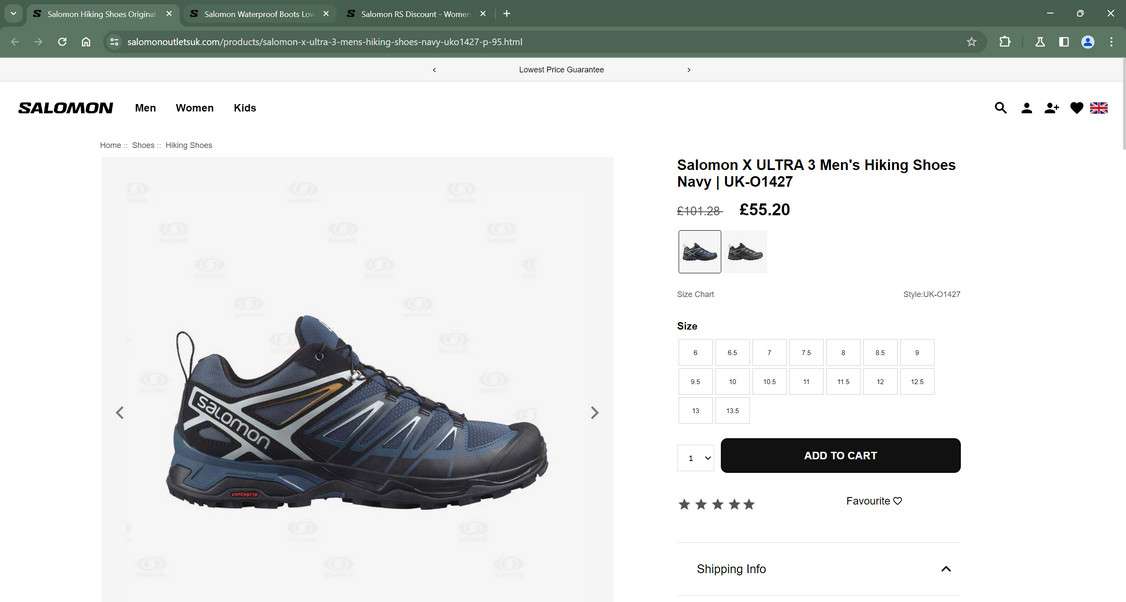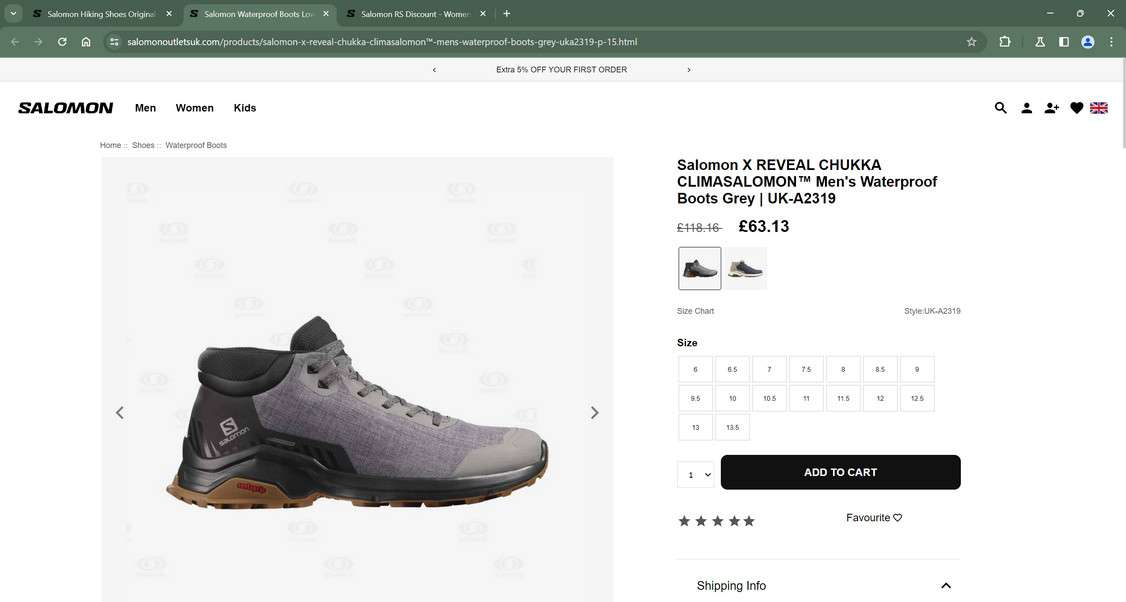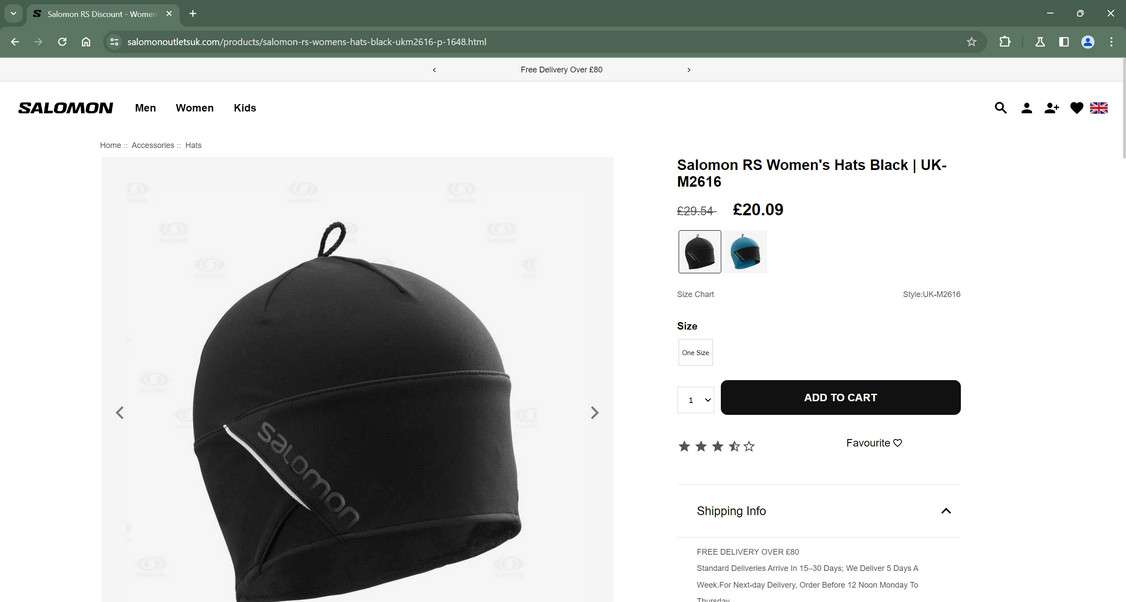Salomon is a popular outdoor sports and winter gear brand known for quality, performance, and innovation. Unfortunately, scammers are exploiting Salomon’s trusted name to trick customers into buying from fake websites that imitate the real Salomon store.
This scam heavily promotes “clearance sales” with unbelievable discounts up to 90% off on Facebook, Instagram, TikTok and other platforms. The ads lure customers to visit fraudulent Salomon shopping websites that use the company’s logo and images. However, the products, while advertised as deeply discounted Salomon items, are typically low-quality fakes or customers receive nothing at all after purchase.
This article will provide an in-depth look at how the scam works, tips to identify fake Salomon websites, what to do if you fell victim, and how to protect yourself from these retail scams.



Overview of the Salomon 90% Off Clearance Sale Scam
The Salomon clearance sale scam operates by setting up fake e-commerce stores under the Salomon brand name. Scammers create lookalike websites with the Salomon logo, product photos and branding throughout.
To attract customers, they heavily promote “blowout” clearance sales with absurd discounts up to 90% off on social media platforms like Facebook, Instagram and TikTok. The ads even mention real Salomon products like popular hiking boots and skis.
If a person clicks on one of these ads, they are taken to a scam Salomon website to purchase products at incredible bargain prices. However, this is a fraudulent store intent on stealing money and personal information.
Victims will either receive a low-quality item or nothing at all for their money. The scammers quickly take down their fake sites once enough orders come through. Then they reuse the scheme all over again under a new domain name.
This scam takes advantage of Salomon’s trusted reputation and the temptation of huge discounts. Always be wary of “limited time” clearance sales with unbelievable prices from brands sold online. If an offer seems too good to be true, it almost always is.
How the Fake Salomon Websites Operate
The fake Salomon websites run like professional-looking online stores with categorized products, reviews and interactive elements. But they are facade e-commerce sites built specifically to scam customers.
Here is how the fraudulent sites work:
- Domain names – The sites use domain names intended to look like real Salomon urls. Examples include slight misspellings like salamon.com or including “official” like salomonofficialstore.com.
- Branding – The scam pages use Salomon’s logo, fonts, product photos and overall branding throughout the site. This falsely implies association with the real company.
- Images and content – All product descriptions, customer reviews, company info, return policies and site images are stolen from the real Salomon website or catalog.
- Pricing – Prices are set at unbelievable discounts like 90% off or $25 for a $500 ski jacket. This signals a scam, since brands rarely offer sales over 50% off.
- Limited time offers – Countdown timers, “Going out of business” and other limited-time messaging creates a false sense of urgency. This pressures customers to purchase without closer inspection.
- No real contact info – The sites only provide an email address or fake phone numbers and addresses. There is no legitimate way to contact the “company.”
- Checkout and payment – Checkout uses typical payment options like major credit cards, PayPal or Amazon Pay. This builds trust for entering personal and payment details that are stolen.
The slick website designs combined with the Salomon branding and huge discounts easily deceive online shoppers. But there are warning signs to recognize these shopping sites are not legitimate.
How the Salomon Clearance Sale Scam Works
Here is a step-by-step breakdown of how this scam operates from promotion to purchase:
1. Promote Fake Sales on Social Media
The scam begins by running sponsored ads on Facebook, Instagram, TikTok and Google. The ads tout deals like “Salomon Clearance Sale! Up to 90% off” and “Store Closing Sale.”
Many feature products like popular boots and skis next to crazy low prices like $25 or $29. The ads also include urgency messaging like “Limited time only!” to prompt immediate action.
2. Drive Traffic to a Fake Salomon Website
When a user clicks on one of these social media ads, they are redirected to a fake Salomon website completely designed to scam visitors.
The site has the Salomon logo and branding all over. The products shown match the real Salomon catalog with detailed descriptions and images stolen from Salomon.com.
But a closer look shows subtle signs it’s an illegitimate site. The domain name may be misspelled, the discounts are unrealistic, and there is no real contact information.
3. Entice Customers With Huge Discounts
The fake site displays insane discounts up to 90% off all products. These are prices far below what any retailer offers, especially on brands like Salomon.
For example, a $500 ski jacket is advertised at $29 or premium hiking boots at $39 instead of $200. Countdown timers, “going out of business” messages and limited quantity claims create urgency to buy immediately.
4. Complete the Checkout Process
If a customer adds items to their cart, they go through the checkout process like a normal online store. The site asks for all the standard details: name, shipping address, email, and payment information.
The payment options even include legitimate providers like Visa, PayPal and Amazon Pay. This builds further trust in the transaction, although the payment details will be stolen.
5. Receive a Low-Quality or No Product
Weeks later, instead of the Salomon products ordered, victims receive:
- A cheap fleece or knit hat if anything at all.
- Used, damaged or completely different products than advertised.
- Nothing – no items ever ship out after the purchase.
Meanwhile, the scammers make off with the stolen money and payment information. They take down the fake site and reopen under a new name once enough people file complaints.
6. Information and Money is Stolen
Beyond just taking money for product orders, the scammers also gain personally identifiable information (PII) submitted by customers online.
All the names, email addresses, shipping details and payment information entered on the site can be used for identity theft down the road.
The website itself is untraceable, with fake contact info making it impossible for victims to recover stolen funds or information.
This is why it’s critical to watch for red flags and avoid submitting data to sketchy websites promoting unbelievable deals.
8 Signs a Salomon Website is a Scam
While the fake sites look convincing on the surface, there are tells upon closer inspection that reveal their fraudulent nature:
- Website domain – Inspect the url for misspellings or extra words like “official.” Salomon’s real domain is salomon.com.
- Contact information – No real “Contact Us” with physical addresses and working customer service numbers.
- Social media links – No links to Salomon’s actual social profiles. The real site has active Facebook, Instagram, etc.
- Too-good-to-be-true discounts – Real brands rarely offer more than 50% off, so 90% discounts are highly suspicious.
- High-pressure tactics – Countdown timers, “going out of business,” “only 3 left” etc. signal a scam.
- No secure checkout icon – No https protocol or padlock icon in the browser url bar during checkout.
- Poor website quality – Bad grammar, typos and other unprofessional touches common on scam sites.
- No refund policy – No return or exchange information listed. Salomon offers returns and exchanges normally.
Whenever an online deal seems too good to be true, err on the side of caution. Verify the website is legitimate by looking for the signs above before submitting payment or personal data.
How to Identify the Scam on Social Media
The fake Salomon sales are heavily promoted via sponsored posts and ads on Facebook, Instagram, TikTok and other platforms. Here’s what to look for on each:
Spotting the Scam on Facebook
Watch for Facebook ads using:
- Excessive discounts in the ad text like “90% off” or “$25 Salomon Boots Today Only!”
- Countdown timers and other pressure tactics like “Going out of business sale!”
- Stolen Salomon product images in the visual creative
- Links to suspicious domains instead of salomon.com in the ad copy
- Very broad targeting resulting in irrelevant ads
- Minimal comments and reactions compared to ad spend behind the posts
Spotting the Scam on Instagram
Look for Instagram scam ads with:
- Crazy low prices called out in the visual creative like “Boots just $29!”
- Suspicious captions with slogans like “Store Closing Sale!” and “Today Only!”
- Salomon’s logo and product shots in the imagery
- An underwhelming number of likes and comments relative to reach
- Profile with no authentic content or engagement beyond the ads
Spotting the Scam on TikTok
Identify fake TikTok ads using:
- Videos promoting clearance events with 90% off or similar messaging
- Captions urging viewers to click the link before a deadline
- Brand logos, products, and even people in the videos
- URLs in the captions and bios that don’t point to salomon.com
- Very generic and repetitive comment responses hinting at bots/fake accounts
Always scrutinize unbelievable social media discounts, limited-time offers, and pressured selling from known brands. Verify legitimacy before clicking any links or believing the deals advertised.
What to Do If You Fell Victim to the Fake Salomon Website Scam
If you placed an order on one of these fraudulent sites posing as Salomon, here are important steps to take:
Immediately Contact Your Bank
If you paid with a credit or debit card, call your bank right away. Report the charge as fraudulent so they can start a chargeback dispute to reverse the payment. Provide details on the scam website and that the products ordered were never received.
Report Issues to Payment Processors
If you paid through PayPal, Amazon Pay, Apple Pay or another provider, contact their customer support. Report the transaction and request they investigate the scam merchant to help prevent future fake purchases.
Watch for Identity Theft Activity
Keep monitoring your credit reports and financial account statements closely for any signs of misuse of your personal information. Set up transaction alerts on all credit/debit cards used on the site. Place a fraud alert on your credit file.
File a Complaint With Authorities
Submit a complaint with the FBI’s Internet Crime Complaint Center (IC3) and the Federal Trade Commission. Provide both agencies with details on the scam, fake website, payment method, and losses. This helps authorities track and stop online retail scams.
Warn Other Potential Victims
Leave comments about the scam under the Facebook/Instagram ads leading to the fraudulent website to warn others not to fall for it. Report the ads as scams directly to the social networks. Spread awareness about this ruse with friends who shop online.
Only Dispute Charges for Unreceived Goods
Some scam victims still receive cheap, used or wrong products. Only dispute the payment if your order never arrives or the items were not as explicitly advertised. Getting undesirable goods from overseas scammers does not justify a blanket chargeback in all cases.
Being proactive after falling for a retail scam limits damages from lost money to stolen identity information. And advising others helps curb the scam’s success and reach.
How to Avoid Salomon Clearance Sale Scams: 5 Tips
Here are five tips to protect yourself from clearance sale scams using the Salomon name:
1. Beware Social Media Discount Ads
Approach ads promoting clearance sales or other bargain deals on social channels with extreme caution. Discounts over 50% and urgency tactics are red flags. Click with care before engaging further.
2. Verify the Website’s Legitimacy
Thoroughly inspect sites you visit from social ads prior to any purchases. Watch for misspellings, lack of contact info, false reviews, and other scam red flags covered earlier.
3. Price Check Deals Against Official Site
Open Salomon’s actual site in a separate tab to compare advertised product prices. If items cost significantly less on the other site, it’s likely a scam.
4. Use Credit Cards Over Debit Cards
Never enter your bank debit card number on sketchy websites! Credit cards offer stronger protections for disputing fraudulent charges.
5. Trust Your Instincts
If an offer seems unrealistic or too good to be true, do not submit payment or personal details. Go directly to a retailer’s real website URL to find sales.
Remember, reputable retailers rarely if ever offer discounts over 50% off. By applying these tips when shopping online, you can avoid clearance sale scams that misuse trusted brands like Salomon.
Frequently Asked Questions About the Fake Salomon Sales
Many people have questions about the fraudulent Salomon websites promoting clearance sales and discounts. Here are answers to some frequently asked questions about this scam.
Are the Salomon 90% off deals on Facebook real?
No. Any advertisements on social media for Salomon clearance sales with discounts over 50% off are scams. Salomon rarely offers more than 50% off even during major sales. Ignore and report any 90% off ads as fraudulent.
How can I tell if a Salomon website is fake?
Inspect the URL for odd spellings or domains not associated with the official Salomon.com site. Watch for prices that seem too good to be true, recycled Salomon product images, and lack of legitimate contact information or social media links.
What happens if I order from a fake Salomon website?
You either will not receive anything, get a low-quality counterfeit item, or a completely random product like sunglasses instead of the boots or skis you ordered. The scammers pocket your money and use stolen payment info for fraud.
Can I get a refund if I purchase from a scam website?
If you used a credit card, you can request a chargeback from your credit card company for any fraudulent transactions. Debit cards and other forms of payment are less likely to recover lost funds.
How do I report a fake Salomon website or sale ad?
Notify Salomon directly about any fraudulent websites misusing their brand. Submit details to the FBI Internet Crime Complaint Center. Report scam ads to the social networks where you saw them.
Is Salomon aware of the clearance scam?
Yes. Unfortunately Salomon and many top brands constantly battle online scammers creating elaborate fake sale scams. They try to get scam sites shut down, but new ones quickly pop back up.
How can I avoid these fake Salomon sales scams?
Stick to the real salomon.com website for any purchases. Approached advertised sales cautiously, especially if discounts seem unrealistic. Verify site legitimacy through contact details, URLs and other signs before providing payment info.
Are other major retailers also targeted with similar sale scams?
Yes. Many top outdoor apparel and gear brands like The North Face, Burton, and Mammut fall victim to these “blowout sale” scams from time to time. Always verify legitimacy before assuming advertised sales are real.
Be wary of unbelievable clearance deals and carefully inspect sites before making Salomon or other major brand purchases advertised at too-good-to-be-true prices. Use caution and verification to avoid these fake retail sale scams.
Conclusion: Shop Smart to Avoid Fake Online Sales Scams
Salomon has become the latest major retail brand exploited by scammers promoting fake clearance sales online for under $50. These lookalike websites feature the company’s logo and product catalogs to deceive customers into thinking they’re on the real Salomon site in order to steal money and information.
The scam playbook uses social media ads, extreme discounts up to 90% off, and limited time pressure tactics to drive traffic to the fraudulent sites. While the stores look legit on the surface, inspecting closely reveals subtle but common scam site characteristics like no real contact info, misspellings, sketchy urls, etc.
If you fell victim after submitting payment, immediately contact your bank and payment providers to halt charges. Monitor closely for any misuse of stolen personal information provided online. Report all details to the FTC and FBI fraud divisions to assist investigations.
To avoid online retail scams, always approach unbelievable deals with skepticism. Verify legitimacy, compare prices, use credit cards, and trust your instincts before providing payment details or other sensitive information. Your caution can protect your money, identity and peace of mind.










